Text

Ty Lee + Traditional Thai clothes
(ID in alt text)
6K notes
·
View notes
Photo
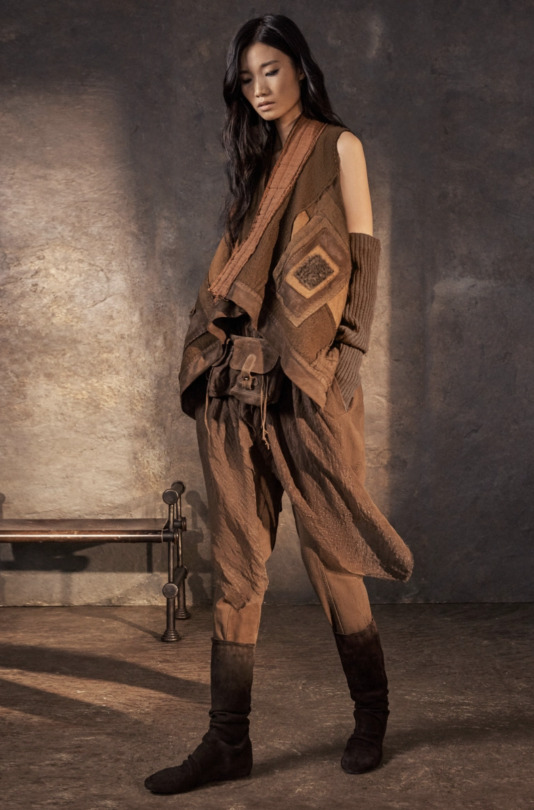
Zhang fashion
Urban Zen Fall 2018
5 notes
·
View notes
Text
Cultural Fashion: Aunt Wu

Okay, I officially retract my previous post about Aunt Wu’s head dress.
By pure accident, I’ve stumbled across the real inspiration behind Aunt Wu’s character design: jūnihitoe (十二単) robes. Junihitoe robes are a style of formal court dress first worn during the Heian period by noble women and ladies-in-waiting in the Japanese Imperial Court. Nowadays, this style of dress can be seen on hina dolls and members of the Japanese royal family during important ceremonies. Although much less elaborate, Aunt Wu’s clothing shares a similar silhouette and many design elements with junihitoe robes: wide sleeves, thigh-length coat, and a long skirt split down the middle to show off an underskirt.
Paired with the ceremonial junihitoe robes is the ceremonial hairstyle called osuberakashi (大垂髪), meaning “great bound hair”. Osuberakashi is a hairstyle meant to show off the impressive length of a woman’s hair; the hair close to the scalp is styled into a large bouffant while the remainder of the hair is tied into a low ponytail. The bouffant is decorated with traditional hair accessories or kamiagegu (髪上げ具): the crescent-shaped accessory is a decorative hair comb called a hirakushi (平櫛) and the circular accessory is called a hirabitai (平額). The ponytail is decorated with colorful hair ties. Aunt Wu’s hair possesses all of these characteristics and accessories, although her hirabitai lacks the decorative prongs of the original— probably for ease of animation.
I don’t think there’s any particularly deep reason for why they chose this style for Aunt Wu. The overall junihitoe aesthetic looks elegant, important, and long-standing— an image that Aunt Wu tries hard to foster. I guess we could headcanon that Aunt Wu might originally be from Kyoshi Island, since her cultural inspiration is the same (Heian-period Japan).
Fun Fact: Wigs emulating this traditional hairstyle are available online. They’re called marukamoji (丸髢).
Like what I’m doing? Tips always appreciated, never expected. ^_^
https://ko-fi.com/atlaculture
281 notes
·
View notes
Text
I don’t know how many people would be interested but I do have a few other fashion blogs for various fandoms. If you want to check them out here’s the links: @atla-fashion, @dc-comics-fashion, @narutofashion, @she-ra-fashion, @inuyasha-fashion, @bnha-fashion, @marvel-comics-fashion, @lotr-fashion, and @onepiecefashion
177 notes
·
View notes
Text
Cultural Fashion: Agni Kai Armbands
Been wanting to do a series of posts on the Southeast Asian influences on Fire Nation culture. Lets start off simple:
Agni Kai Armbands
I didn’t notice it the first time I watched ATLA, but on repeated viewings I saw that all the characters would wear bands around their upper arms during official Agni Kais. I’m 99.9% certain these armbands (and the complimentary lack of shirts) are inspired by the prajiad (ประเจียด) bands worn in Muay Thai. Note the similarities:

According to multiple sources, the prajiad (ประเจียด) is believed to grant good luck to the wearer during battle. The armbands were traditionally fabric torn off a mother’s dress and tied around the arms. The symbolic act represented a mother’s blessing for the safety of the wearer.
Assuming these cultural practices also hold true in the Fire Nation, this makes Ozai’s burning of Zuko even more vicious. He was a child wearing gifts given to him by his missing mother for good luck, only to be brutally attacked by his own father. It is deeply symbolic of Ursa’s inability to truly protect Zuko from Ozai.
6K notes
·
View notes
Text
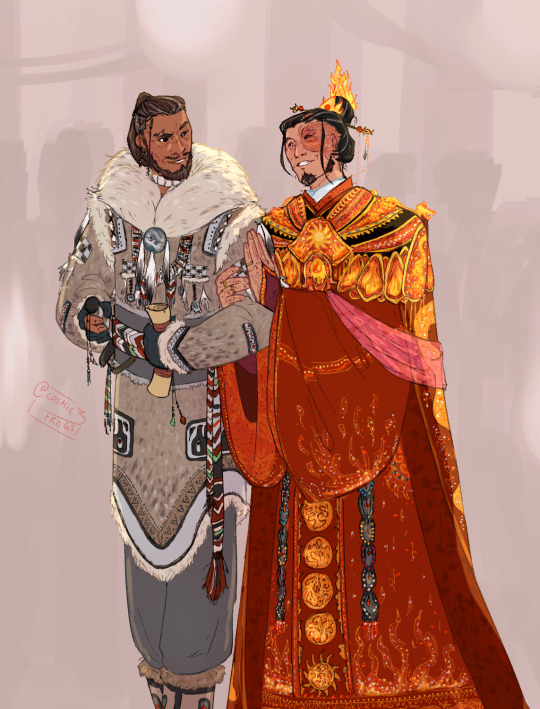
I wanted to go a bit more in-depth with this piece that I did for zukka week 2023 because i got inspired to do more insane clothing details. ID in ALT.
Ramble about the influences/inspirations below:
Design inspirations for Sokka's clothing are mainly Inuvialuit and Yup'ik, with Nenets, Tlingit, and Chukchi inspiration for the tassels, patterns, belt and beadwork. I mixed these with the ornaments canon shows us used by the Northern Water Tribe, and also in Legend of Korra. I got particularly excited about drawing from Inuvialuit sources since the tassels we see in canon look like they could be inspired by this. Going beyond canon's animation-friendly colour scheme, I drew from Nenets patterns/embroidery/sashes and Yup'ik beadwork for accent colours. I think in the future I'd like to find ways to incorporate more Tlingit-style patterns since I rarely see them in fanart (which is a shame - they're stunning), but since they tend to be very big I ultimately decided to only include them as a nod in order to keep the regalia recognisable as 'Water Tribe'. I wonder if I could start using Polynesian influences as well?
Zuko's headdress and particularly the shoulder garment and beaded embroidery draw heavily from women's clothing styles of Lê Dynasty Vietnam. The other main influence is men's royal clothing in Tang Dynasty China, and patterns worn by Mongolian Khatun. Since we have a bit more to go on in canon as to what fire nation regalia looks like, I blended that in as well. I got particularly excited about the embellishments on Lê Dynasty clothes because I could give a little nod to Zuko's dragon-fire by adding more colours to the embroidery. In the future I think I'd want to make the Mongolian influence a bit more obvious... perhaps even push the envelope by incorporating some Bashkir designs, though I'm not sure how well that will go.
19K notes
·
View notes
Photo


Water Tribe fashion
Louis Vuitton Fall 2020
5 notes
·
View notes
Text
Cultural Fashion: Royal Earthbender Guards
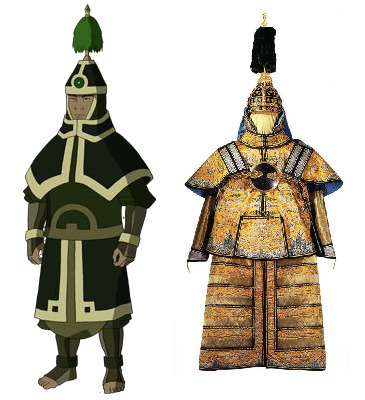
The armor that the Earth King’s Royal Earthbender Guards wear is based off the brigandine armor worn by the elite soldiers of the Qing Dynasty (1636–1912). Brigandine armor, called dingjia (釘甲) in Mandarin, refers to fabric armor lined with small metal plates. Due to its elaborate appearance and protective heft, it was favored by high-ranking warriors. By the late 19th century, however, the armor became largely ceremonial and usually lacked the iron plating. Since Ba Sing Se is mostly inspired by the later years of the Qing Dynasty, the armor that the Earth King’s guards wear is likely just as decorative (and pointless).
It’s quite fitting that the soldiers most responsible for protecting the Earth King wear armor that’s all show and no substance. A perfect reflection of their nation’s puppet ruler.
I also really like their helmets. There’s a pretty cool video of a guy putting on legit brigandine armor on YouTube.
Like what I’m doing? Tips always appreciated, never expected. ^_^
https://ko-fi.com/atlaculture
375 notes
·
View notes
Photo
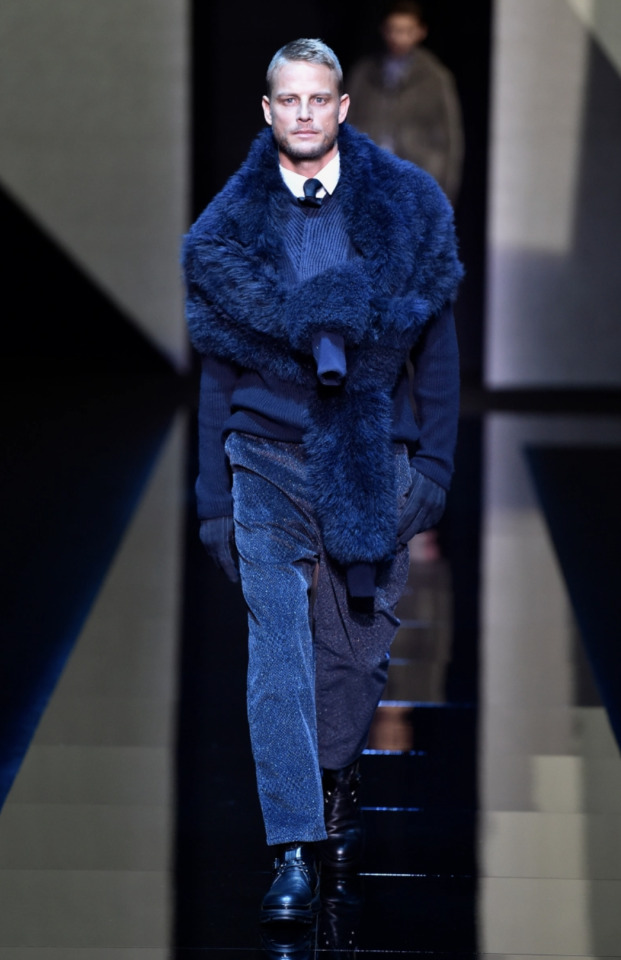

Water Tribe fashion
Giorgio Armani Fall 2017
16 notes
·
View notes
Text
Cultural Fashion: Yue’s Hair
I love Yue’s design. Not only is it very aesthetically appealing, but it also perfectly marries the dual cultural influences of her character. For example, her unique hair reveals so much about her:
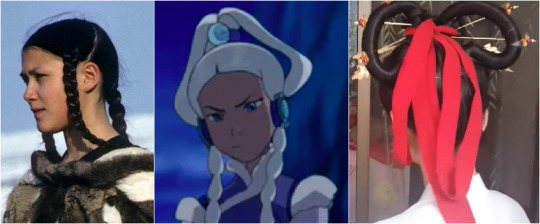
As you can see, Yue’s hairstyle is a combination of both traditional Inuit and Chinese hairdos; Inuit in the front and Chinese in the back, if you will. This fancy ‘do is the perfect hairstyle for an Inuit-inspired princess who will eventually become a Chinese-inspired lunar figure. But wait! There’s more!
Yue’s Chinese hairdo is reminiscent of the Flying Immortal Hairstyle (飞仙髻/Fei Xian Ji) and it’s a hairdo frequently featured in depictions of the Chinese moon goddess, Chang’e:
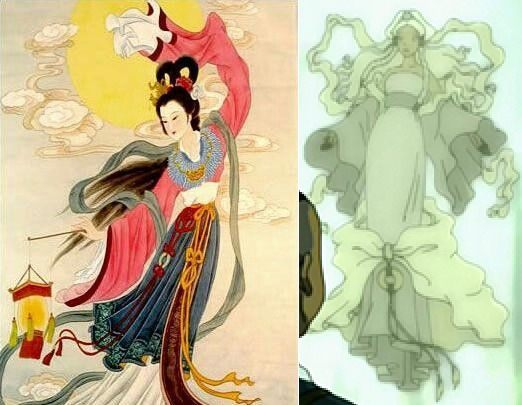
So yeah, if there were ever a hairstyle that could say “I’m going to turn into the moon, buddy”, it would be this one.
8K notes
·
View notes
Text
Cultural Fashion: Hair Loopies
Dissecting the real life cultures that influenced show. First up is Katara’s trademark ‘do!
Hair Loopies
So this first fact actually comes from the Twitter poster, Low Arctic (https://twitter.com/LowArctic). The reference pictures used are screenshots from Atanarjuat: The Fast Runner (Inuktitut: ᐊᑕᓈᕐᔪᐊᑦ).
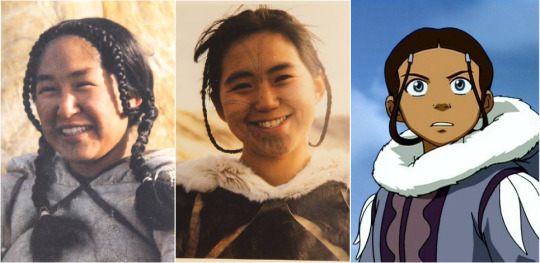
While braided hair is common in many cultures, Katara’s trademark “hair loopies” are uniquely Nunavut Inuit. According to Tumblr user Atagotiak, who is of Inuk descent, hair loopies are known as qilliqti in Inuktitut. While her “loopies” are drawn un-braided in the show for ease of animation, I’d love to see them thinly braided and decorated with bright blue beads in the live-action adaption.
Here is another examples of qilliqti or “hair loopies” in real life and Avatar:
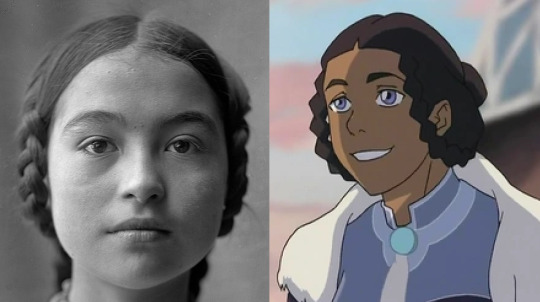
The young woman photographed is Nancy Columbia, an Inuit-American beauty queen, actress, and screenwriter from the Silent Film Era. When I try to imagine Katara as a real person, she ends up looking a lot like Nancy.
Like what I’m doing? Tips always appreciated, never expected. ^_^
https://ko-fi.com/atlaculture
4K notes
·
View notes
Text
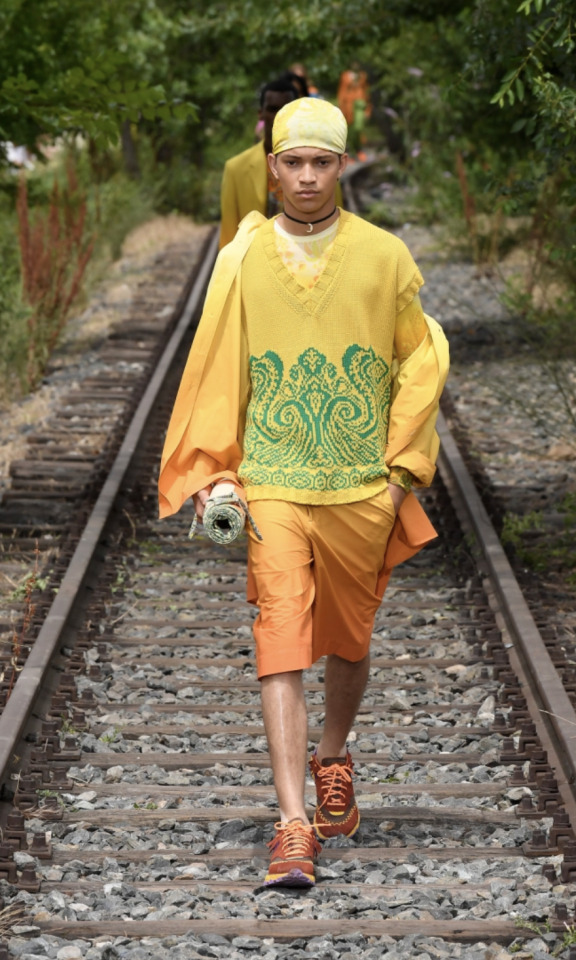
Outfit for Aang
Etro Spring 2022
19 notes
·
View notes
Photo
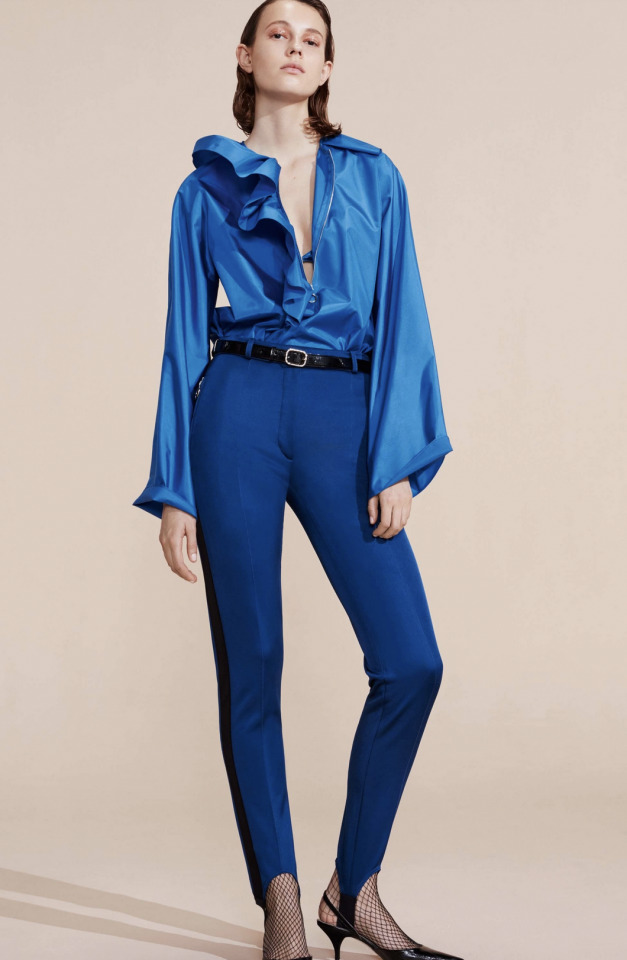
Outfit for Varrick
Nina Ricci Resort 2017
9 notes
·
View notes
Photo

Outfit for June
Ralph Lauren Resort 2014
9 notes
·
View notes
Text
Cultural Fashion: Ba Sing Se Headdresses
In terms of fashion, I would say that Ba Sing Se is probably my favorite locale in Avatar: The Last Airbender. And my favorite piece of Ba Sing Se fashion would have to be the beautiful headdresses that the fancy ladies of the Upper Ring wear. While not entirely accurate to their real-life inspirations, they are nonetheless colorful and stylized versions of the headdresses that Manchurian women wore during the Qing Dynasty (1636–1912).
Shout out to @guzhuangheaven for this post, which helped me a lot during the research process for this particular post.
Liangbatou
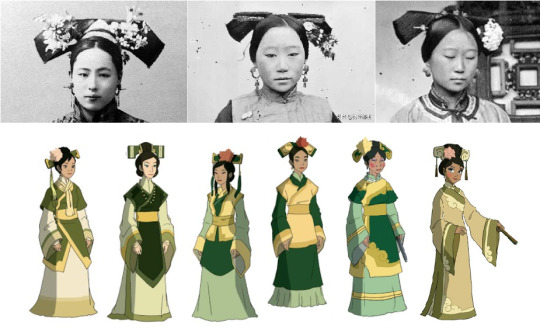
Liangbatou (两把头) refers to a traditional Manchurian woman’s hairstyle in which hair is wrapped around a long frame known as a bianfang (扁方) to create a rigid, wingspan-like shape. The hair is then decorated with flowers and hairpins.
As I mentioned earlier, their Avatar equivalents aren’t quite historically accurate. In real life, bianfang were meant to be mostly covered up by a woman’s hair or hair extensions; they weren’t necessarily meant to be decorative on their own as they’re shown in ATLA. That said, I still really enjoy the show’s take on liangbatou as it really contributes to the Upper Ring’s atmosphere of opulence.
Dalachi

Manchurian noblewomen’s penchant for grand, gravity-defying displays of hair decor reached its apogee during the late Qing Dynasty (mid-19th century to very early 20th century). During this period, the elaborately coiffed hair wings of the liangbatou were replaced with the more streamlined but still extravagant dalachi (大拉翅). Instead of wrapping their hair around a frame to achieve the fashionable wingspan shape, Manchurian noblewomen began to wear their hair in buns covered by large black headdresses (dalachi) that allowed them even more room for decorations like flowers and tassels. It also seems like the dalachi gave the illusion of having even more hair to wear up than the liangbatou.
Like the previously mentioned hairstyle, the dalachi in Avatar are much more colorful than their real life counterparts. Nonetheless, I still find them to be very pretty, especially the one with the tassels that the poetry teacher wears.
Like what I’m doing? Tips always appreciated, never expected. ^_^
https://ko-fi.com/atlaculture
845 notes
·
View notes
Photo

Outfit for Fire Lady Ilah
Yumi Katsura Spring 2017
12 notes
·
View notes
Photo

Outfit for Baatar Beifong Jr
Dries Van Noten Spring/Summer 2019
#baatar beifong jr#baatar jr#earth kingdom#legend of korra#atla fashion#dries van noten#menswear#green
3 notes
·
View notes